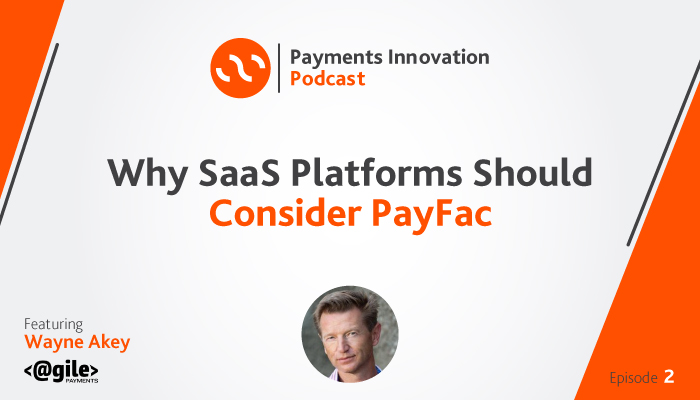Recently on Payments Innovation, Chris D’Antuono had an enlightening conversation with Wayne Akey from Agile Payments about why SaaS platforms should consider being part of a payment facilitator program, also known as PayFac.
Agile Payments has been involved in the payments landscape for about 20 years. In that time their niche has been partnering with software service platforms and embedding payments.
Here’s what we learned from Wayne’s expertise.
PayFac in a nutshell
In the past few years, PayFac, or payment aggregation, has become incredibly desired by SaaS platforms due to its ability to bring on new clients very quickly. Not only are new clients pouring in, the pain points of having to conventionally bore a merchant via a traditional merchant account have also been removed.
“The payment facilitation model, (or payment aggregation) is becoming more and more attractive for SaaS platforms.” – Wayne Akey
In the beginning there was PayPal
Traditionally there was PayPal, which was the original user of this model.
When PayPal started, the whole aggregation model of being a master merchant was unknown. Paypal was doing something that had never been seen before, including their backhand credit card processing acquiring bank.
As PayPal grew, the volume was there and the acquiring bank partners had to support the model.
Now there’s Square who is coming into that space and doing the same thing, and they use that ability to onboard customers to grow rapidly.
It’s the primary reason why they were able to acquire millions of customers.
But there’s a price to pay
The issue with playing in that kind of arena is that it is very expensive. You can pay one hundred thousand to two hundred thousand dollars upfront, and the same amount yearly with compliance cost.
For the average software service platform, going down the road of becoming a full grown PayFac or payment facilitator is:
1. VERY expensive
2. It also requires them to term what their platform is to also becoming a payments company.
This is well beyond what most of those companies desire and what they want to do. These companies don’t want to worry about risk mitigation or having to bring on a compliance officer. The only wish is to be able to accept payments in an easy way.
Because of this, companies have come to recognize that there is a gap between what’s available and what merchants really need right now.
Within that gap, what type of requirements do PayFacs have to invest in to be able to support this type of business?
From base model to a full blown model
The new options that are available for SaaS platforms range from saying, “We just want to get our payments imbedded and we want to go to market as fast as possible.”
In the base model, a company can go to market in 2 weeks. They offer the payment solution and are able to tell their clients, “Fill out the form we will have your processing payments in 15 minutes.” The merchant record is the payment facilitator partner, and that’s kind of their base.
However, as a company moves from a base model to a full blown model, there’s going to be give and take.
With the ability to come on really quickly and go to market, there’s a drawback.
The cost basis will be higher than if a company assumes more risk and responsibility.
“If a business is just wanting to get to market as soon as possible and payment-related revenue is not your most important consideration, this is a good option for you.” – Wayne Akey
PayFac to expand globally
The issue with the PayFac model is it originated in the USA. At its core, it is a very US and Canada option.
However, the demand for global capabilities is growing. PayFac providers are looking to expand globally by growing themselves and partnering with other FinTechs.
There are some areas where this is already happening such as the UK and the EU. Asia is slightly behind the curve in this arena, and it is problematic for US companies who have clients in those areas.
There has been some progress, but there are definitely some geographic weaknesses in this model. This kind of problem really stresses the importance of having partners rather than taking on a full operation in a new jurisdiction.
Besides spending a lot of time and money, companies may be moving into areas where they don’t really know the legalities and how things truly work.
That’s why leveraging other FinTech’s experience and know-how will not only save loads time and money but also massively decrease speed to market for a company looking to grow in payfac space.
4 Challenges to becoming a payment facilitator
- The card associations are going to want an incredible amount of information about a company because they are trusting the company to onboard merchants whom they may not have direct control over, nor do they have control over the potential fraud risk that they might bring into the ecosystem.
- To become a true PayFac, companies are going to have to go through a fairly onerous underwriting process where company principals and business models are thoroughly examined.
- Anyone who is a startup and considering the full blown model has to have investment capital behind them to be able to afford this.
- There is also the time. It takes 6 months or more to get approved and to get the integration valid.
Conclusion
As a platform considering PayFac, there is a lot to think about and there are a lot of moving pieces. It’s best to start with a conversation with someone who knows what they are doing. Have a conversation where you look at the options and sort out where you are now, and where do you want to go in the future.
If you’re interested in Agile Payments, check out their website and contact Wayne to learn more.
This article is based on an interview with Wayne Akey president of Agile Payments. You can find this interview and many more, by subscribing to Payments Innovation.


